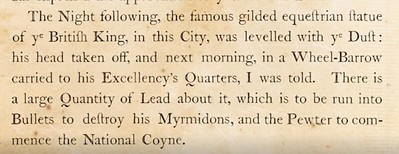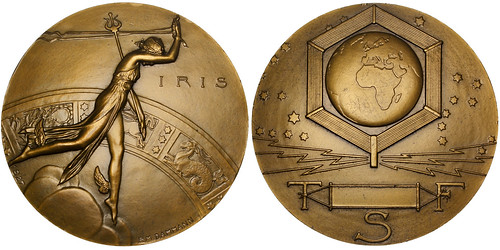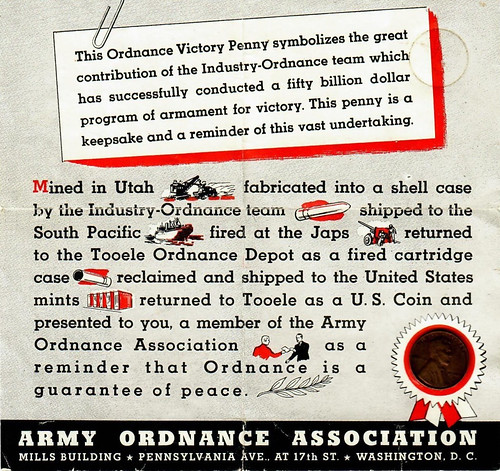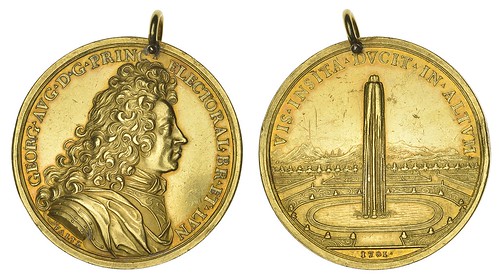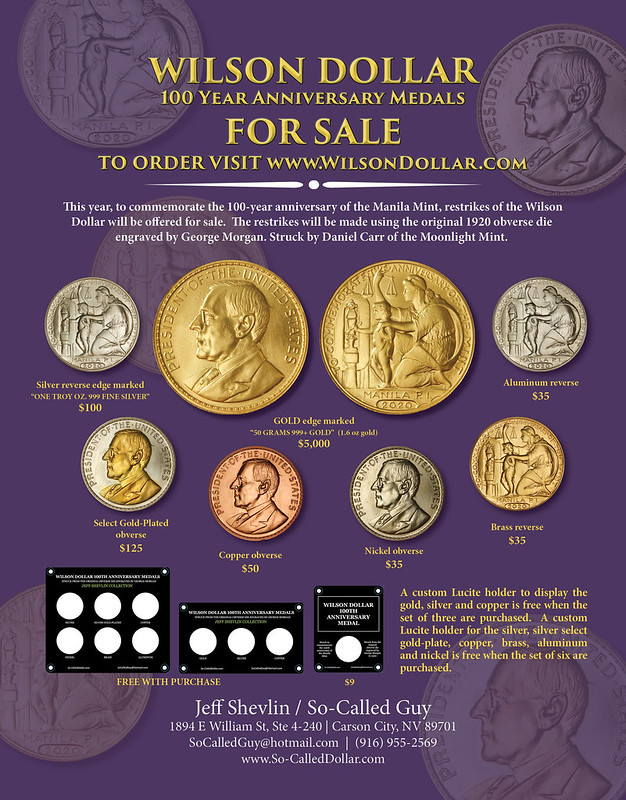
Visit our NBS Sponsors


|
About Us
The Numismatic Bibliomania Society is a non-profit association devoted to the study and enjoyment of numismatic literature. For more information please see our web site at coinbooks.org SubscriptionsThose wishing to become new E-Sylum subscribers (or wishing to Unsubscribe) can go to the following web page link MembershipThere is a membership application available on the web site Membership Application To join, print the application and return it with your check to the address printed on the application. Print/Digital membership is $40 to addresses in the U.S., and $60 elsewhere. A digital-only membership is available for $25. For those without web access, write to: Charles Heck, Treasurer AsylumFor Asylum mailing address changes and other membership questions, contact Chuck at this email address: treasurer@coinbooks.org SubmissionsTo submit items for publication in The E-Sylum, write to the Editor at this address: whomren@gmail.com BUY THE BOOK BEFORE THE COINSale Calendar |
- WAYNE'S WORDS: THE E-SYLUM APRIL 4, 2021
- NEW BOOK EXAMINES 1913 LIBERTY NICKELS
- SECOND NNP SYMPOSIUM VIDEOS AVAILABLE
- STEINBERG'S FIXED PRICE LISTS ON NNP
- DAVID R. CERVIN: FIRST DATED CHRISTIAN COINAGE
- NO STATUE WAS HARMED TO MAKE CONTINENTALS
- NOTES FROM E-SYLUM READERS: APRIL 4, 2021
- LOVE TOKENS ON COUNTERFEIT SEATED QUARTERS
- MANSHIP'S DIANA AND FLIGHT OF EUROPA
- VOCABULARY TERM: DEBONDED, DEBONDING
- JOSEPH NAPOLEON TRICOT LEVICK (1828-1908)
- 2022 NYINC EDUCATIONAL PROGRAMS
- MORE ON NON-FUNGIBLE TOKENS
- WORLD BANKNOTE AUCTIONS SALE 7 HIGHLIGHTS
- NUMISMAGRAM SELECTIONS: APRIL 2021
- SECOND TEMPLE PERIOD SHEKEL REDISCOVERED
- ROMAN SILVER COIN HOARD FOUND IN BULGARIA
- PIRATE YEMENI COINS IN COLONIAL AMERICA
- 1792 EAGLE-ON-GLOBE QUARTER PATTERN
- ORDNANCE VICTORY PENNIES
- BRITANNIA'S EVOLUTION
- GERMAN GEORGE II MEDAL OFFERED
- SIEGE OF PEKING BOXER REBELLION MEDAL
- GEORGE FLOYD'S COUNTERFEIT $20 BILL
- PROTESTERS SPRAY DYE ON BANK OF ENGLAND
- LOOSE CHANGE: APRIL 4, 2021
- RIVERBOAT DISASTER THREATENED CHEROKEE PAYMENT
Click here to read the thin version on the web
Click here to subscribe
Click here to access the complete archive
To comment or submit articles, reply to whomren@gmail.com
Content presented in The E-Sylum is not necessarily researched or independently fact-checked, and views expressed do not necessarily represent those of the Numismatic Bibliomania Society.
WAYNE'S WORDS: THE E-SYLUM APRIL 4, 2021
 New subscribers this week include:
Gail Gabrysh, courtesy Steve Costner;
Mike Geidel, and
Lyn Linker.
Welcome aboard! We now have 6,641 subscribers.
New subscribers this week include:
Gail Gabrysh, courtesy Steve Costner;
Mike Geidel, and
Lyn Linker.
Welcome aboard! We now have 6,641 subscribers.
Thank you for reading The E-Sylum. If you enjoy it, please send me the email addresses of friends you think may enjoy it as well and I'll send them a subscription. Contact me at whomren@gmail.com anytime regarding your subscription, or questions, comments or suggestions about our content.
This week we open with one new book, multiple updates from the Newman Numismatic Portal, Notes From E-Sylum readers, and more.
Other topics this week include love tokens on counterfeit quarters, medal designer Paul Manship, J.N.T. Levick, non-fungible tokens, World Banknote Auctions highlights, coin finds, the 1792 Eagle-on-Globe pattern, ordnance victory pennies, a Boxer Rebellion medal, and George Floyd's counterfeit $20 bill.
To learn more about 1913 Liberty Head nickels, Steinberg's Fixed Price Lists, the first Christian dated coinage, Continental Dollar origins, Libertas Americana medals, die varieties, Columbia farthings, the Jules Fonrobert sale, the Diana Ashtray, debonding, the New York International, Poland Government-in-Exile notes, Britannia, George II, and the Turing Challenge, read on. Have a great week, everyone!
Wayne Homren
Editor, The E-Sylum
NEW BOOK EXAMINES 1913 LIBERTY NICKELS
Coin World reported this week on an upcoming book by John Dannreuther on U.S. Proof nickel alloy coinage. Here's a short excerpt; see the complete article online. -Editor
 Although the three 1913 Liberty Head 5-cent coins in private hands are certified as Proofs by Professional Coin Grading Service, new soon-to-be-published research by professional numismatist John Dannreuther indicates all five clandestinely made 1913 coins were struck with circulation quality dies on unpolished planchets.
Although the three 1913 Liberty Head 5-cent coins in private hands are certified as Proofs by Professional Coin Grading Service, new soon-to-be-published research by professional numismatist John Dannreuther indicates all five clandestinely made 1913 coins were struck with circulation quality dies on unpolished planchets.
The new findings also suggest that the U.S. Mint had full intentions to strike 1913 Liberty Head 5-cent coins for general circulation.
Dannreuther is putting the finishing touches on his manuscript for a new reference on United States Proof nickel alloy coinage that will include new revelations regarding the 1913 Liberty Head 5-cent coins.
SECOND NNP SYMPOSIUM VIDEOS AVAILABLE
The second NNP Symposium is history, and was another great success. Congratulations to everyone involved, from the organizers and speakers to the participants who attended. I was pleased to have the opportunity to speak in the panel session on The Early Days of Online Numismatics.
Here's the post-event announcement; the videos are available now and forever on the Newman Portal. Share links to your favorite talks with your friends, or take a break and watch some of the talks you missed at the time. We'll all look forward to the next event. -Editor
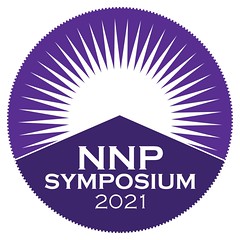 Videos from the recently concluded NNP Symposium (March 19-21) are now posted on Newman Portal. Produced by Lianna Spurrier of Numismatic Marketing, this event featured a total of 37 speakers presenting on a wide variety of numismatic topics, including United States, ancient, and world numismatics.
Videos from the recently concluded NNP Symposium (March 19-21) are now posted on Newman Portal. Produced by Lianna Spurrier of Numismatic Marketing, this event featured a total of 37 speakers presenting on a wide variety of numismatic topics, including United States, ancient, and world numismatics.
Among the presenters was John Brush, who provided a overview of the formation and evolution of the D. L. Hansen collection. This session included a lively question & answer exchange with the audience. Ken Bressett discussed his storied numismatic career, most notably covering the development of the Guide Book over the years. Shanna Schmidt delivered an overview of the ancient coin auction marketplace, noting a number of differences for those us more familiar with the largest U.S. auction firms. These are a just a few of the highlights, with the full list available on Newman Portal.
STEINBERG'S FIXED PRICE LISTS ON NNP
The latest additions to the Newman Numismatic Portal are Steinberg's Fixed Price Lists. Project Coordinator Len Augsburger provided the following report. Thanks. -Editor
Steinberg's Fixed Price Lists on Newman Portal
The late William Fox Steinberg (1913-1995), dealer in world gold coins, founded Steinberg's in 1950. The firm is currently headed by Robert L. Steinberg (William's son) and Michael D. Sottini (Robert's step-son). Steinberg's has generously made available the historic fixed price lists of this firm, and these have been recently scanned by Newman Portal. The currently posted group covers 1974-2020 and we anticipate adding additional issues going forward. Although not completely illustrated, this material will enable the discovery of "needles in haystacks," for example the presentation here of a Kuwait 1960 gold pattern 3 dinars, from the Winter 1978 / Spring 1979 fixed price list.
Link to Steinberg's Fixed Price Lists on Newman Portal
https://nnp.wustl.edu/library/publisherdetail/541978
Link to search Steinberg's Fixed Price Lists:
https://archive.org/details/newmannumismatic?and%5b%5d=creator%3A%22steinberg%27s%22
THE BOOK BAZARRE
DAVID R. CERVIN: FIRST DATED CHRISTIAN COINAGE
These are selections from the David Lisot Video Library that feature news and personalities from the world of coin collecting. David has been attending coin conventions since 1972 and began videotaping in 1985. The Newman Numismatic Portal now lists all David's videos on their website at:
https://nnp.wustl.edu/library/multimediadetail/522852
David Lisot writes:
"In the spirit of Easter here is numismatist David Cervin talking about the first dated Christian coinage!"
First Three Christian A.D. Dated Numismatic Items
 Multi-Media Summary: David Lisot Video Library (1992)
Multi-Media Summary: David Lisot Video Library (1992)
It was over one thousand years after the death of Jesus Christ before coins were dated with the Anno Domini numbering system. Hear fascinating stories of the first Christian dated coins as told by veteran collector David R. Cervin. You"ll hear tales of kings, Crusades, and powerful Bishops in this extraordinary video as well as see close-up examples of the coins.
Speaker: David R. Cervin.
An excerpt of the video is available for viewing on NNP at:
https://nnp.wustl.edu/library/book/578852
NO STATUE WAS HARMED TO MAKE CONTINENTALS
April 1st is behind us. We were more low-key about April Fool's Day this year, with just one item courtesy the Newman Numismatic Portal. That new Continental dollar evidence? Sorry, April Fool! There's no evidence that the coins were struck from metal from the statue of King George III destroyed by a mob of New York City patriots in 1776. -Editor
Bill Eckberg writes:
"The image of the "collector" who bought the arm and hand was my first clue. The ending gave it away.
"Lianna's a really good straight-faced satirist."
NOTES FROM E-SYLUM READERS: APRIL 4, 2021
The Harry Lelande Auction CatalogDave Hirt writes:
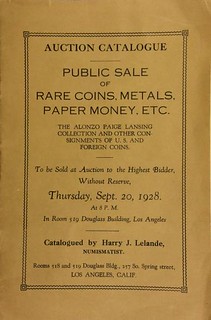 "Reading through The E-Sylum last week I came to John Lupia's bio of Harry Lelande. Thank you John!! I never knew anything about him before, although I have owned a copy of his only auction sale catalog for years, but in all that time I had never read about Lelande himself. The auction catalog I own is hand priced. As such, I believe it is very rare. The ANS copy is not listed as being priced."
"Reading through The E-Sylum last week I came to John Lupia's bio of Harry Lelande. Thank you John!! I never knew anything about him before, although I have owned a copy of his only auction sale catalog for years, but in all that time I had never read about Lelande himself. The auction catalog I own is hand priced. As such, I believe it is very rare. The ANS copy is not listed as being priced."
Thanks. I added an image of the cover of the American Numismatic Society's copy of Lelande's 1928 sale from the Newman Numismatic Portal. It's a nice sale of varied material including colonials, a Chain cent, medals, a Lesher dollar, Confederate and Southern States Currency, Encased Postage, and numismatic literature, including an impressive run of The Numismatist. -Editor
To read the catalog on NNP, see:
Public sale of rare coins, metals, paper money, etc., the Alonzo Paige Lansing collection ... of U.S. and foreign coins ... [09/20/1928]
(https://nnp.wustl.edu/library/auctionlots?AucCoId=511144&AuctionId=520399)
To read the earlier E-Sylum article, see:
HARRY JASON LELANDE (1871-1965)
(https://www.coinbooks.org/v24/esylum_v24n13a14.html)
Other topics this week include Libertas Americana medals, die varieties, the Worthy Coin Co. Bid Board, the Missing Queen, and more. -Editor
LOVE TOKENS ON COUNTERFEIT SEATED QUARTERS
Jeremy Bostwick submitted these notes on the mysterious lettered love tokens on counterfeit Liberty Seated Quarters. Thanks! -Editor
Regarding the mysterious love token on a fake Seated Quarter, this is actually something that I have been looking into since last summer when I acquired one with a "P." I thought that it was just odd in that it was a love token on a counterfeit, but looking at it more, it seemed not be engraved on the reverse. I then discovered a second one on the archives of the Seated Liberty collector site (this time with an "S," but otherwise the same style, with the same obverse die. I wrote to them about it, and my note was published (on page 24 of the August 2020 E-Gobrecht).
MANSHIP'S DIANA AND FLIGHT OF EUROPA
Bob Mueller submitted this article on the works of artist Paul Manship. Thanks! -Editor
From Medals to Monuments
Paul Manship's Diana and Flight of Europa
First and foremost, I would like to dedicate this submission to the memory of Dick Johnson and Joe Levine, whose recent passing within two months of each other has been heavy on my heart and left a palpable void in the medallic art community.
The current exhibition "Paul Manship: Ancient Made Modern" at the Wadsworth Atheneum focusing on his artistic development is the impetus for this brief essay, since, as pointed out in the last issue of The E-Sylum, his medallic work was basically overlooked.
VOCABULARY TERM: DEBONDED, DEBONDING
Here's another entry from Dick Johnson's Encyclopedia of Coin and Medal Terminology. This is a short one, but I thought it would be a good follow-on to last week's entry on clad coinage; specifically, what happens when the cladding comes apart - either by mistake or on purpose. I added an image from Error-Ref.com. -Editor
Debonded, Debonding. The separation of an outer clad layer of metal either before or after striking. It is caused by poor adhesion during the bonding process. On a struck piece debonding is considered a clad metal anomaly because of the incorrect preparation of the strip and planchet. It would be described in numismatic literature as a lamination error. The purposeful debonding (as with skeleton scrap) to recycle the metal is accomplished by heating the clad strip to a specific temperature, holding the metal at that temperature until the bond weakens, then physically pulling apart the separate layers.
JOSEPH NAPOLEON TRICOT LEVICK (1828-1908)
Here's another entry from the online draft of John Lupia's book of numismatic biographies. Thanks! This is an excerpt with the full article and bibliography available online. This week's subject is American numismatic giant J.N.T. Levick. -Editor
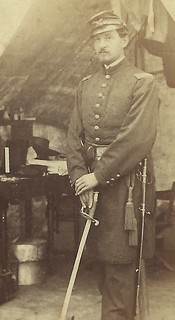 Joseph Napoleon Tricot Levick (1828-1908), was born in New Orleans, Louisiana. However the GAR Muster Roll of December 16, 1892 lists him as 58 years of age making him born in 1834.
Joseph Napoleon Tricot Levick (1828-1908), was born in New Orleans, Louisiana. However the GAR Muster Roll of December 16, 1892 lists him as 58 years of age making him born in 1834.
About 1855, he moved to Philadelphia, Pennsylvania, and a member of that city's and the nation's first numismatic club – the Philadelphia Numismatic Society. He worked in an office on Front Street in the same building where Ebenezer Locke Mason, Jr., also worked. The two became good friends socially and in coin and stamp collecting.
During the Civil War Levick enlisted as a private on April 19, 1861, and subsequently was mustered in on June 15, 1861, at Philadelphia, Pennsylvania as a 2nd Lieutenant. He had previously been a private for 30 days in Company "H", 7th New York Militia. On June 20, 1861, he was assigned to Company "I", 70th New York Volunteer Infantry Regiment, Sickle's Brigade (a.k.a. the 1st Excelsior Regiment of the Excelsior Brigade). He was promoted to First Lieutenant on April 30, 1862. On May 5, 1862 he saw action for the first time at Fort MacGruder. The next day he was brevetted to Captain for conspicuous gallantry in battle. Levick was discharged on May 18, 1863, with the rank of 1st Lieutenant.
2022 NYINC EDUCATIONAL PROGRAMS
Additional numismatic education events have been announced for the next New York International. Here's the latest press release. -Editor
 The educational presentations at the January 7-16, 2022 50th Annual New York International Numismatic Convention, to be held at the Grand Hyatt New York, located at 109 East 42 nd Street have been broadened to include a lecture by New York Numismatic Club member and Past President Jai Chandrasekhar, The Life and Work of French Medal Maker and Sculptor Alexandre Charpentier. In addition to his work as a medallist and sculptor, Charpentier was also a cabinet and furniture maker and worked in tin, marble, wood, leather and terra cotta. He lived from 1856-1909.
The educational presentations at the January 7-16, 2022 50th Annual New York International Numismatic Convention, to be held at the Grand Hyatt New York, located at 109 East 42 nd Street have been broadened to include a lecture by New York Numismatic Club member and Past President Jai Chandrasekhar, The Life and Work of French Medal Maker and Sculptor Alexandre Charpentier. In addition to his work as a medallist and sculptor, Charpentier was also a cabinet and furniture maker and worked in tin, marble, wood, leather and terra cotta. He lived from 1856-1909.
Mr. Chandrasekhar graduated from Yale University in 1987 and went on to earn his Juris Doctor degree from Yale Law School in 1997, where he was the Book Review Editor for the Yale Law Journal. In the course of his legal career he has served as a Staff Attorney with the Enforcement Division of the Securities and Exchange Commission. Prior to his SEC service he was with the firm of Sullivan and Cromwell LLP. He currently serves as Senior Counsel for Bernstein Litowitz Berger & Grossman LLP. A member of the New York City and New York State Bar Associations, he serves as Secretary of the New York County Lawyers Association.
MORE ON NON-FUNGIBLE TOKENS
When I first saw the news article about the basketball platform Top Shot, I thought it would make a great "decoy" article for last week's April Fool E-Sylum issue - something true, but so out-there-sounding, that people would think it's a joke. But I guess nothing fazes people anymore. Non-Fungible Tokens (NFTs) may or may not be here to stay, but they're certainly the craze of the moment. NFTs or something like them may well eventually worm their way into the numismatic world. -Editor
Joel Orosz writes:
"I had not heard of NFTs before, and I must confess that I am among those chowderheads who just don't get it. Blockchain technology guarantees that you own an authentic, albeit virtual, video clip that can be viewed for free on the Internet. Wouldn't this be like paying $208,000 to virtually own Pledges of History, which can be viewed for free on NNP? I paid less than 1% of that to own two differently-inscribed copies of the same book. I didn't get blockchain verification straight back to 1846, however, so perhaps I was literally taken for a ride by not having two virtual books blockchain-backed instead of two literally signed-by-the-author ones. "
WORLD BANKNOTE AUCTIONS SALE 7 HIGHLIGHTS
Here are some highlights from the upcoming World Banknote Auctions sale. -Editor
 World Banknote Auctions Premier Sale 7 is listed now and has live bidding on our website and through our mobile apps on April 15th at 10 AM PST. This sale features highlights from around the world, including a great group of Canada and a strong British Commonwealth collection, highlighted by the sole PMG graded uncirculated example of an issued British Caribbean Territories $20.
World Banknote Auctions Premier Sale 7 is listed now and has live bidding on our website and through our mobile apps on April 15th at 10 AM PST. This sale features highlights from around the world, including a great group of Canada and a strong British Commonwealth collection, highlighted by the sole PMG graded uncirculated example of an issued British Caribbean Territories $20.
Lot 7053: 1963 British Caribbean Territories $20
NUMISMAGRAM SELECTIONS: APRIL 2021
Jeremy Bostwick from Numismagram forwarded along these highlights from his most recent upload of new medallic art to his website. In addition to the items below, look for some alluring Art Nouveau and Art Deco items, along with some exceptionally brilliant and prooflike World War I-themed medals. For all of this month's new pieces, please visit numismagram.com/inventory. -Editor
101594 | FRANCE. Télégraphie sans Fil [Radio] Art Deco bronze Medal.
Issued 1927. The emergence of wireless or radio communication (67mm, 137.86 g, 12h). By P. Dammann in Paris. IRIS, Iris striding right among the clouds, head lowered, holding trident-headed scepter and streamers; in background, zodiacal band with Scorpio, Sagittarius, and Capricorn / View of the Earth, focused upon Europe and Africa, surrounded by hexagonal, segmented antennae, the bottom segment of which is emitting radio waves; stars in the background, T S F [Télégraphie sans Fil = telegraph without wires] below. Edge: «cornucopia» BRONZE. Jones, Art of the Medal, 423. Mint State. Yellow-bronze surfaces, with some very lightly scattered spotting. One of the iconic and rarer Art Deco medallic works of the period. $465.
Following the proof of the existence of electromagnetic waves by German physicist Heinrich Hertz in 1887, a flurry of other scientific minds turned to a new medium for study—the "airwaves." Guglielmo Marconi's invention of the radio, for which he won the 1909 Nobel Prize in Physics, furthered what would become a rapidly growing industry during the first three decades of the 20th century, as communication now need not be reliant upon the connection of wires. Here, Dammann captures this novel technology and pairs it with another movement indicative of its era—the refined, elegant, and geometric artistry that embodies Art Deco.
SECOND TEMPLE PERIOD SHEKEL REDISCOVERED
In the hey-what's-in-this-old-box? department, Arthur Shippee forwarded this Jerusalem Post article about the rediscovery of a rare Second Temple Period Tyrian shekel. Thanks! -Editor
In the midst of one of the most comprehensive conservation projects currently taking place in Israel, archeologists in Jerusalem's Old City discovered a Tyre coin, believed to have been used to pay the Temple tax by pilgrims making their way to the Temple for Passover, Shavuot or Sukkot.
The ancient coin was found inside a box of artifacts originally excavated in the 1980s, when the last conservation project took place at the site. The box was somehow lost and only discovered recently as part of a well-needed conservation project currently taking place at the Tower of David Museum.
ROMAN SILVER COIN HOARD FOUND IN BULGARIA
Arthur Shippee passed along this article about a coin find in Bulgaria. Thanks. -Editor
 A coin hoard containing nearly 600 silver coins (denarii) from the 1st – 3rd century AD, most likely hidden during the first large-scale barbarian invasion of the Roman Empire, the invasion by the Goths in 250-251 AD, has been discovered by archaeologists alongside a partially preserved skeleton in a burned down building in ancient Philipopolis, today's Plovdiv in Southern Bulgaria.
A coin hoard containing nearly 600 silver coins (denarii) from the 1st – 3rd century AD, most likely hidden during the first large-scale barbarian invasion of the Roman Empire, the invasion by the Goths in 250-251 AD, has been discovered by archaeologists alongside a partially preserved skeleton in a burned down building in ancient Philipopolis, today's Plovdiv in Southern Bulgaria.
The impressive treasure, a collection of silver coins (denarii), includes coins minted by all Emperors, Empresses-consorts, and some other royalties of the Roman Empire from Antonius Pius (r. 138 – 161 AD) until Philip I the Arab (r. 244 – 249 AD) and Philip II.
PIRATE YEMENI COINS IN COLONIAL AMERICA
Ross Johnson forwarded this Associated Press story about specimens of Arabian silver coins found by detectorists at Colonial Period sites in New England. -Editor
 A handful of coins unearthed from a pick-your-own-fruit orchard in rural Rhode Island and other random corners of New England may help solve one of the planet's oldest cold cases.
A handful of coins unearthed from a pick-your-own-fruit orchard in rural Rhode Island and other random corners of New England may help solve one of the planet's oldest cold cases.
The villain in this tale: a murderous English pirate who became the world's most-wanted criminal after plundering a ship carrying Muslim pilgrims home to India from Mecca, then eluded capture by posing as a slave trader.
"It's a new history of a nearly perfect crime," said Jim Bailey, an amateur historian and metal detectorist who found the first intact 17th-century Arabian coin in a meadow in Middletown.
1792 EAGLE-ON-GLOBE QUARTER PATTERN
This Heritage press release discusses the rare 1792 Eagle-on-Globe pattern. -Editor
One of just four known Eagle-on-Globe examples heads to auction April 22-26
One of four existing 1792 Judd-13 Eagle-on-Globe quarter dollar patterns, among the earliest pieces produced by the fledgling US Mint, appears fresh to market in Heritage Auctions' U.S. Coins Signature Auction, April 22-26 on HA.com.
"As one of the hobby's most coveted patterns, we're proud to bring this piece of numismatic and U.S. history to auction," said Greg Rohan, President of Heritage Auctions. "The inclusion of a white metal 1792 Eagle-on-Globe quarter in a sale is a landmark event."
ORDNANCE VICTORY PENNIES
With permission, we're republishing this nice item on shell case cents by Bill Myers in the April 3, 2021 (Series 22 No. 2468) issue of MPC Gram, the newsletter for collectors of Military Payment Certificates and other military numismatica. Thanks! -Editor
Many years ago, Fred sent me a scan of his E-bay purchase. It was a folder from the Tooele Ordnance Depot with a US cent minted from 1944 to 1946 that was minted from brass reclaimed from shell casings (copper added to the 70% copper, 30% zinc shell casing to make 95% copper and 5% zinc). It was labeled as a "victory penny, it's been to war". Of course, my reaction was "I want one"! I found one on E-bay and bought it. Just last week I was searching E-bay last week and I came across a card with a 1944S cent composed of copper from the shell casing reclaimed at the Tooele Ordnance Department (should be Depot). It was a souvenir from the Utah Fair Association. I have not found much about the Utah Fair Association after World War II so I cannot determine the date this card was released but I assume it was close to the end of World War II.
THE BOOK BAZARRE
BRITANNIA'S EVOLUTION
Louis Golino published an article on World Mint News Blog about the evolution of the Royal Mint's Britannia. Here's an excerpt - see the complete article online. -Editor
 Long before Lady Liberty, Marianne, Germania, and other allegorical numismatic and cultural figures, there was Britannia — the oldest symbol of a nation personified as a strong female still used on coins today.
Long before Lady Liberty, Marianne, Germania, and other allegorical numismatic and cultural figures, there was Britannia — the oldest symbol of a nation personified as a strong female still used on coins today.
Her roots are in the Roman conquest of Britain and the use of deities that began in ancient Greece and Rome that first personified concepts like Liberty with a female goddess called Libertas in Rome and Eleutheria in Greece.
GERMAN GEORGE II MEDAL OFFERED
Dix Noonan Webb is offering a German gold medal with the earliest known portrait of George II. Here's the press release. -Editor
A gold medal showing the earliest known portrait of Georg August, Electoral Prince of Brunswick-Calenburg-Hanover, who would later become King George II, is to be offered in a sale of Coins and Historical Medals on Tuesday & Wednesday, April 6 & 7, 2021 at International coins, medals, banknotes and jewellery specialists Dix Noonan Webb.
Dating from 1701, the year of his 18th birthday, the medal shows the Prince, who was the last British monarch born outside England, on one side and Schloss Herrenhausen, Hanover on the other. It is estimated at £6,000-8,000.
SIEGE OF PEKING BOXER REBELLION MEDAL
Stack's Bowers Senior Numismatist and Cataloger Jeremy Bostwick wrote an article about a great medal in their upcoming Hong Kong sale. -Editor
As recounted in one of our previous blog posts, the tensions between westerners and their Chinese hosts reached an untenable level by the summer of 1900, with the Empress Dowager Cixi (the real power behind the Qing dynasty) siding with the "boxers" in what would become known as the Boxer Rebellion. Tired of what they viewed as meddlesome invaders from the west, the alliance between imperial forces and the band of boxers declared war and eventually laid siege to the Legation Quarter in Beijing (Peking), where numerous foreign nationals from many western powers were stationed. After nearly two months, the siege was broken by an eight-nation alliance, with the Qing dynasty being greatly weakened in the aftermath. While many coins date to this period, even more historical appeal is offered by a rare and exceedingly attractive medal in our April Hong Kong auction.
GEORGE FLOYD'S COUNTERFEIT $20 BILL
The New York Times and other news outlets reported this week from the trial of the police officer who killed George Floyd earlier this year, touching off riots nationwide. The incident all began with a $20 bill believed to be counterfeit. -Editor
He chatted with a store clerk about playing football. He grabbed a banana off a shelf, flipped through a wad of cash, and hugged and exchanged pleasantries with a woman, laughing with his hand on her back.
In surveillance footage played for the first time in a Minneapolis courtroom on Wednesday, the world got to see George Floyd as it never had before: He was just another customer in a corner store that he liked to frequent.
PROTESTERS SPRAY DYE ON BANK OF ENGLAND
Protesters defaced the facade of the Bank of England this week. -Editor
Climate activists in London splashed black dye on the facade of the Bank of England's imposing neo-classical headquarters on Thursday as part of a protest against the finance sector's support of what they say is a climate catastrophe.
Activists, some dressed as jesters, sprayed the dye at the building, known as "the Old Lady of Threadneedle Street", leaving black stains on the main entrance to the building.
"This bank is killing us," read a banner held up by one protester. "No more fossil fuels," read another.
LOOSE CHANGE: APRIL 4, 2021
Here are some additional items in the media this week that may be of interest. -Editor
Aaron Oppenheim passed along this article following up on the Georgia man who was dealing with a 500-pound pile of oily pennies from his former employer. -Editor
 Coinstar took up the mantle and picked up the more than 500 pounds of pennies from Flaten on Thursday.
Coinstar took up the mantle and picked up the more than 500 pounds of pennies from Flaten on Thursday.
The company pointed Fox News to a release in which it wrote that it also rounded up Flaten's paycheck to $1,000.
"When we heard about Mr. Flaten's penny problem, we were happy to offer our assistance," said Coinstar CEO Jim Gaherity. "Coinstar has been in the coin business for 30 years and we process approximately 41 billion coins annually – so picking up 91,000 pennies was all in a day's work."
"I was spending an hour or two a night trying to clean the pennies and probably only cleaned off about $5 worth," Flaten told Coinstar. "I was so relieved and grateful that Coinstar agreed to help me."
In addition, company executives announced that they would match Flaten's penny value and donate $1,000 to local charities of his choosing.
Flaten named two Atlanta-area animal shelters to receive the donations.
To read the complete article, see:
Coinstar fixes Georgia man's oily penny paycheck problem
(https://www.foxnews.com/us/coinstar-fixes-georgia-mans-oily-penny-paycheck-problem)
To read the earlier E-Sylum article, see:
THE 500-POUND POMADED PENNY PILE
(https://www.coinbooks.org/v24/esylum_v24n13a35.html)
Other topics this week include Turing Challenge. -Editor
RIVERBOAT DISASTER THREATENED CHEROKEE PAYMENT
When recovered from the ocean floor in 2014, the purser's safe of the S.S. Central America contained a combined total of $1,588.95 face value of U.S. coins from silver dimes to Half Eagle $5 gold coins. From the Oklahoma Muskogee Phoenix comes this story of another steamship and its lost (and found) money. -Editor
 An early steamboat was named the Cherokee, which plied the rivers between New Orleans and Fort Gibson on the Grand River and the Creek Agency on the Verdigris River. In December of 1840, the Cherokee carried as a passenger Captain William Armstrong, the superintendent of Indian Affairs for the western tribes. Armstrong had traveled to New Orleans to secure a payment for the Cherokees in accordance with their treaty with the federal government. The payment of over $100,000 was to be made at Fort Gibson.
An early steamboat was named the Cherokee, which plied the rivers between New Orleans and Fort Gibson on the Grand River and the Creek Agency on the Verdigris River. In December of 1840, the Cherokee carried as a passenger Captain William Armstrong, the superintendent of Indian Affairs for the western tribes. Armstrong had traveled to New Orleans to secure a payment for the Cherokees in accordance with their treaty with the federal government. The payment of over $100,000 was to be made at Fort Gibson.
The paper money making up the bulk of the payment was sealed in watertight kegs. An additional amount in gold and silver coins was locked in two strongboxes and kept in the clerk's office.
After the steamboat had passed Little Rock and was 60 miles upriver of that town, the Cherokee's boiler exploded. Tragically, some 15 crew and passengers were killed and several others were wounded. The boat was badly damaged by the explosion and within an hour sank in the Arkansas River.









